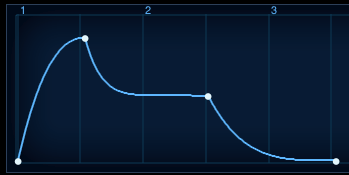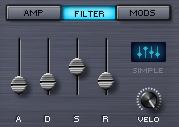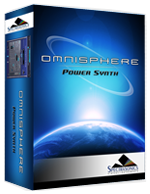EDIT PAGE – ADSR Controls

The ADSR Envelope slider interface operates the same way for all the different envelope types in Omnisphere.

The screenshot above is from the Envelopes Zoom page, but illustrates what a standard ADSR Envelope looks like. The first to second point (or Stage) is the Attack time; the second point is the decay time, which ends at the third point, the Sustain level. After the note is released, the Sustain level drops away based on the Release time.
When viewed on the MAIN page, the ADSR looks like this;

A - Attack

The ‘A’ stands for ATTACK, which means the attack time of the envelope. At minimum setting, the Attack is immediate, so the Envelope will start as soon as a controller triggers it. Higher settings will delay the Attack time, so the Envelope will gradually fade in.
Range between 0 to 20 seconds.
D - Decay

The ‘D’ is the DECAY time, which begins after the Attack has reached its maximum level. At minimum settings, the Decay will be zero, which means there is no Decay after the Attack and the Envelope goes straight to the Sustain stage. At the maximum setting, the DECAY can be about twenty seconds before the Sustain stage starts.
Range between 0 to 20 seconds
S - Sustain

‘S’ is the Sustain Level. Unlike A, D & R, Sustain is not a time value; it's a level value. Sustain determines at what level the Envelope’s output remains constant while a note is held. At the minimum setting there is no sustain, so the envelope’s output will stop until it’s been retriggered. Higher sustain settings mean the Envelope’s output will be constant as long as a note is held down.
R - Release

‘R’ is the Release time value. After a note has been let go, the sound will continue to decay for the duration of the Release time. Raising this fader lengthens the Release time. Lowering it decreases Release time.
Range 0 to 20 seconds.
ENVELOPE TYPES


Since each Envelope is capable of having either simple or complex contours, Omnisphere displays the status of the envelope shape with two icons:
The Simple icon looks like the four ADSR sliders, and will be displayed as long as the envelope has only 4 stages.
When an envelope has more than 4 stages, its icon will change to display the Complex icon, which looks like a Complex envelope, and includes an “X” button.
X BUTTON

When the X button is selected, it will revert the complex envelope contours to a SIMPLE one, and the icon will revert to the SIMPLE icon.
When you want to simplify an envelope, you can use the X button to quickly reset a complex envelope to a simple ADSR style envelope. This can’t be undone, so use it with caution!
NOTE: Changing an Envelope’s shape to complex can only be done by accessing the Envelope Zoom page and adding stages/points.
ENVELOPE DEPTH

The DEPTH controls are dedicated to the four MOD Envelopes. Turning this knob clockwise increases how much of the modulation envelope is sent to the modulation target. The default setting is at maximum.
NOTE: The DEPTH controls for the Modulation Envelopes are independent. The DEPTH control will only affect the selected envelope.
VELO (ENVELOPE VELOCITY)

VELO is short for Velocity Sensitivity. The Velocity knob controls how much MIDI velocity will affect the output signal of the Envelope. Moving the control counter-clockwise decreases the dynamic sensitivity of the envelope and clockwise changes increases the sensitivity.
NOTE: Each of the VELO (Velocity) controls for the two AMP and two FILTER envelopes are independent. The VELO control will only affect the selected envelope.




